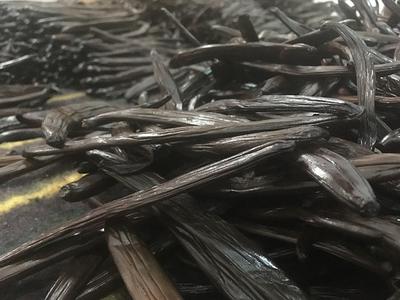VANILLA BEANS | SOYBEAN OIL | SOYA CAKE | COCOA BEANS | COFFEE BEANS
Mexican Vanilla

Vanilla Beans on Sorting Table
Mexican Vanilla
Mexican Vanilla Extract
Mexican vanilla (V. planifolia Andrews): This type of vanilla is sharp, slightly pungent and sweet spicy, but lacks body compared to Bourbon vanilla.
Mexican Pure Vanilla Extract is made from premium, hand-selected beans cultivated in Mexico, the original birthplace of the vanilla plant.
Vanilla grows naturally in the tropical areas of Mexico, Central America and northern South America as well as in the Caribbean.
History of Mexican Vanilla
According to other popular belief, the Totonac Aztec-age people, who inhabit the east coast of Mexico in the present-day state of Veracruz, were among the first people to cultivate vanilla in the 15th century. Aztecs invading from the central highlands of Mexico conquered the Totonacs, and developed a taste for the vanilla pods. They named the fruit tlilxochitl, or "black flower", after the matured fruit, which shrivels and turns black shortly after it is picked. Until the mid-19th century, Mexico was the chief producer of vanilla. In 1819, French entrepreneurs shipped vanilla fruits to the islands of Réunion and Mauritius in hopes of producing vanilla there.
Vanilla grows within the 20-degree band either side of the Equator and is native to the Americas. The vanilla you know best, Vanilla planifolia (also known as fragrans), traditionally grew wild on the Atlantic Gulf side of Mexico from Tampico around to the northeast tip of South America, and from Colima, Mexico to Ecuador on the Pacific side. It also grew throughout the Caribbean.
The Olmeca people on the Gulf Coast of Mexico were perhaps the first to use vanilla as a flavoring in beverages. Before that, vanilla was used as a fragrance in temples and the flowers were placed inside of amulets to protect the wearer from the evil eye.
The Totonaca people of the Gulf coast of Mexico were probably the first people to domesticate vanilla. They continue to cultivate the fruit that they consider was given to them by the gods. Vanilla is a sacred and very important part of their culture and their lives.
Vanilla first left Mexico in the early 1500s on ships bound for Spain. It was originally believed only to have value as a perfume. It wasn’t until Cortes arrived in 1519 that they discovered that it was also used as a flavor.
Until the late 19th century, Mexico had the monopoly on growing vanilla, but now Madagascar grows the majority of the world’s crop. Additional countries that grow vanilla include Costa Rica, Guatemala, Uganda, Kenya, China, India, Indonesia, Papua New Guinea, Tonga, Fiji, Tahiti, Hawaii and other Pacific Islands.
Haven't yet found what you Want...?
If you haven't yet found what you were looking for or you need detailed information about the subject matter on this page then... feel free to ask our business travel consultants. |




